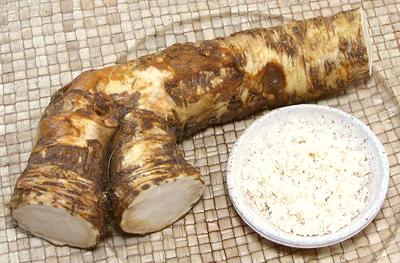 [Meerrettich (German); Seiyo Wasabi (Japan); B. Armoracia rusticana]
[Meerrettich (German); Seiyo Wasabi (Japan); B. Armoracia rusticana]
This pungent white fleshed root was known in Roman times, probably originating in southeastern Europe. Today it is grown worldwide for use as a condiment, particularly popular in Germany, Poland, Russia and surrounding countries. Actually, about 85% of the worlds supply is grown in the bottomlands surrounding Collinsville, Illinois where the soil is just the way horseradish likes it. A mixture of horseradish, mustard seeds and green food coloring is used as a condiment in Japanese sushi bars, even in Japan, because real Wasabi is so costly and perishable.
More on Cabbage Roots.
Wrapped loosely in plastic and stored in the refrigerator horseradish will last a month or more. Well, actually, I found a root in the bottom drawer of my fridge that had been there for at least 9 months. I cut the moldy end off and stuck it in the ground. It grew vigorously.